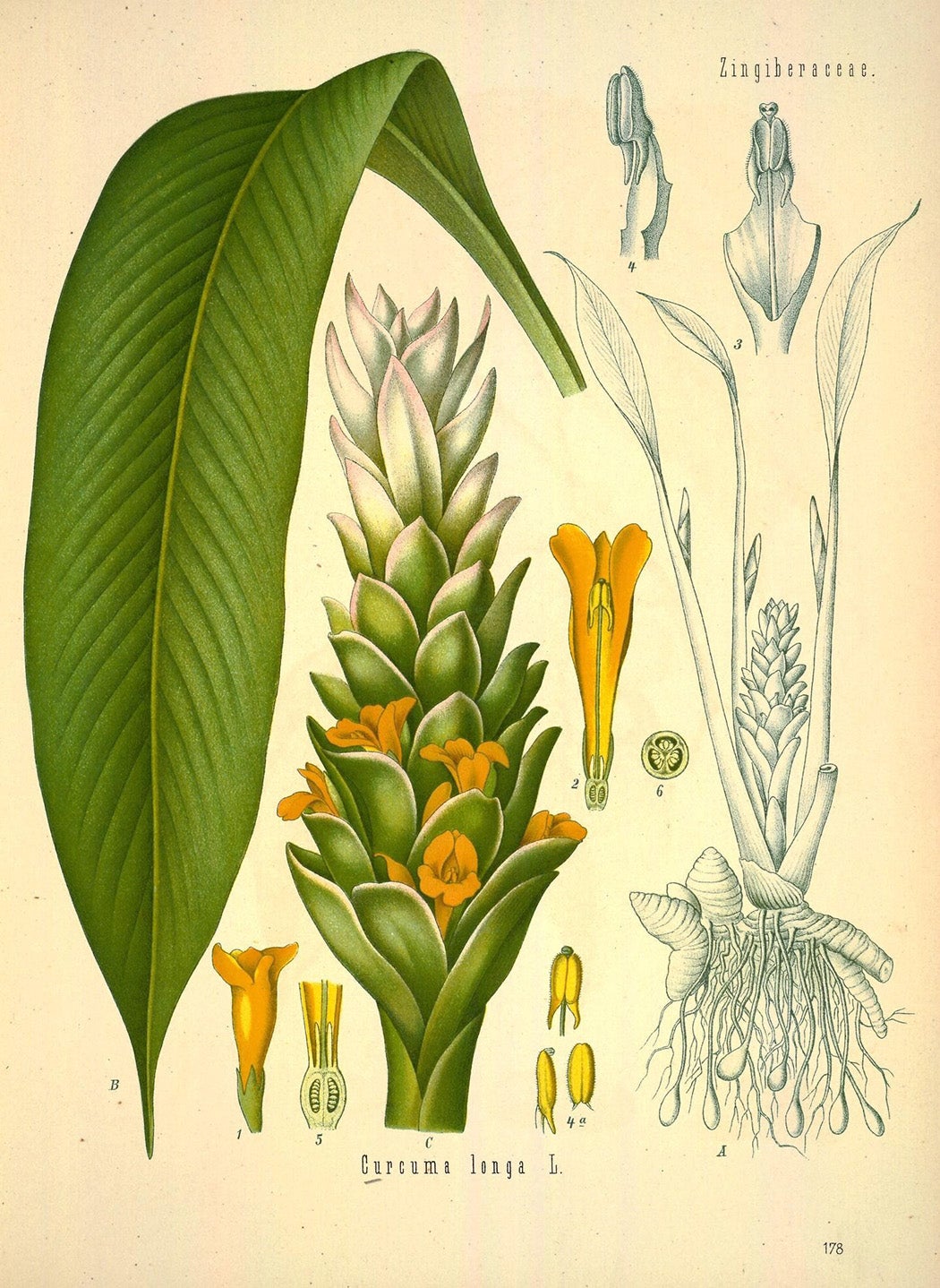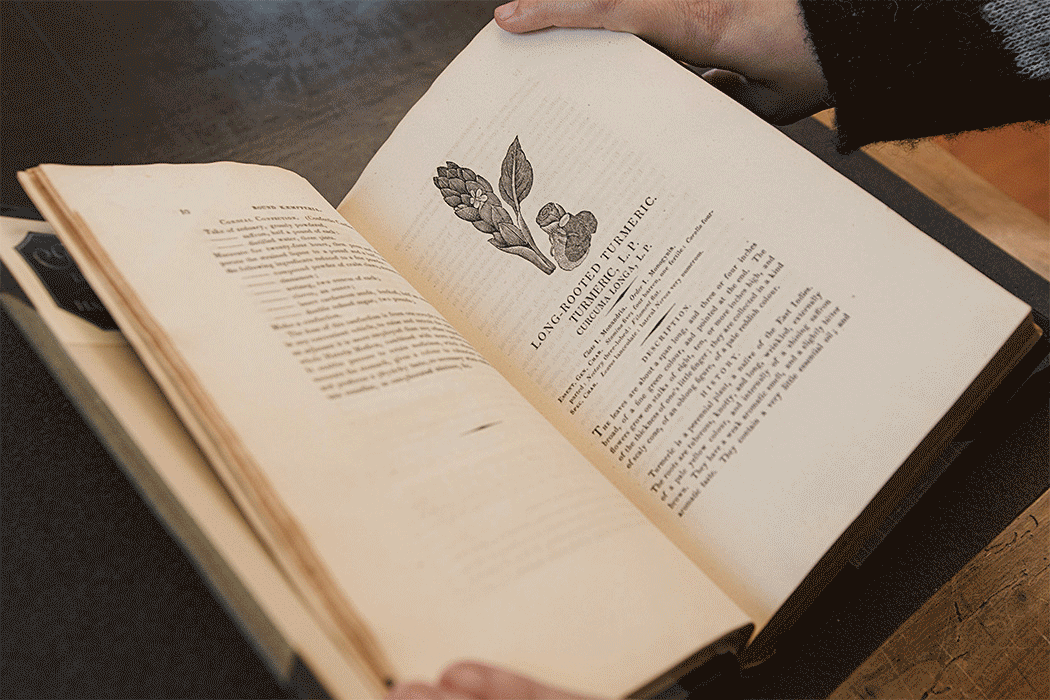Today, we are told to “eat the rainbow”: compose a diet based on the vibrancy and variety of colors of fruits, vegetables, spices, and herbs. Sources as diverse as Lifehacker and the Food Revolution Network promote this idea so much that many people take it as gospel. Mix in a focus on Instagram-friendly meals, and you’ve got artful shots of neon-green matcha and gilded golden milk lattes everywhere you look.
One such plant that is heavily valued for its color, both in its place of origin and beyond, is turmeric. In South and Southeast Asia, where turmeric is from, as geographer David E. Sopher noted, the root of the plant was and continues to be valued for its color. The “similarity of the words for turmeric and yellow in several languages of Southern Asia points to one important role of the plant,” he wrote, explaining that turmeric’s “importance lies in the symbolic value placed on the color by most of the cultures of the area.” Indeed, the root’s color features heavily in certain marriage rites and other ceremonies in the region.
And beyond: A growing turmeric “gold rush” shows that the plant has become a trendy American superfood.
But do we pay any price for our present-day obsession with vibrant foods?
People worldwide love the bright yellow color of turmeric so much that spice producers are turning to toxins to meet both international and local demand. A 2017 study in Public Health Reports, led by environmental health researcher Whitney Cowell, detailed widespread lead contamination in store-bought turmeric. Using mass spectrometry of thirty-two samples collected from stores throughout the greater Boston area, the authors found “detectable levels of lead in all of the samples.” This contamination is no accident: Producers add lead chromate, an industrial paint pigment, to turmeric intentionally, seeking to maintain its vibrant golden color.
Turmeric laden with lead chromate is being sold not only in the United States, but in Bangladesh as well, increasing blood lead levels in its denizens. The authors of the 2017 study quote one turmeric grower in Bangladesh—which exports much of the spice sold worldwide—who said that “traders use the artificial color [lead chromate] to hide the marks of pest attacks and other spots on raw turmeric. It is used during boiling and polishing to make the spice look brighter and attract big buyers, including spice processing firms.”

But where does this international obsession with turmeric’s golden hue come from? There are a variety of culturally, historically, and geographically contingent explanations for this phenomenon. In the West, the coveting of turmeric has a five-hundred-year-long history traced in the pages of European herbals.
Although the exact date that turmeric arrived in Europe is up for debate, it likely came en masse via medieval trade routes. In the early modern period, English and other European writers were captivated by the golden color of the root. For example, John Parkinson’s 1640 work Theatrum Botanicum, a treatise acquired by the Dumbarton Oaks rare book collection, details that the root gives a “yellow color like saffron,” “is very yellow both within and without,” and “is slender and yellow.”
Other herbals in the large collection at Dumbarton Oaks confirm the early modern English fascination with the color of turmeric. A 1694 herbal of plants used in “physick and surgery” notes that many Englishmen and women found turmeric’s hue novel—or even strange. The English author notes that the “People of China…make an Ointment with this root” and “anoint their Bodies all over,” pointing out to his readers that this may “seem very odd [to] those that are unaccustomed to it, by reason of the yellow Colour.”
Why did English consumers so value the plant’s color? Scholar Stephanie Maroney suggests in a recent book chapter that the yellow color was prized as a marker of what the English understood as “exotic” and helped “visually mark the dish as different from traditional ‘English’ food.” A mid-eighteenth-century manuscript receipt book held by the Folger Shakespeare Library illustrates just how this spice was understood as wholly foreign.
Weekly Newsletter
“Mrs. Wills” gives a recipe for “Frangas Incapadas,” an English adulteration of a Portuguese moniker for chicken soup, served upon rice “half coloured with Turmeric.” In a recipe already marked as different by its Portuguese-language name—foreign-language titles are somewhat unusual in the Folger recipe books—turmeric is added for color, not taste. This suggests the way turmeric was used as a visual symbol of the “exotic,” perhaps drawing upon Portuguese colonization of spaces in the Indian Ocean world.
The legacy of the West’s obsession with the color of turmeric has contributed to its transformation into a superfood craze. Colonial and orientalist legacies continue to structure food systems today, even in the so-called postcolonial era. Our ideas and expectations surrounding turmeric have not only shaped cuisine worldwide, they have also compelled people to take extreme measures to preserve its “yellowness,” even to the point of endangering human health. The Plant Humanities Initiative investigates how plants like turmeric tell important stories about the effects of imperialism and other global cultural processes in our everyday lives.







